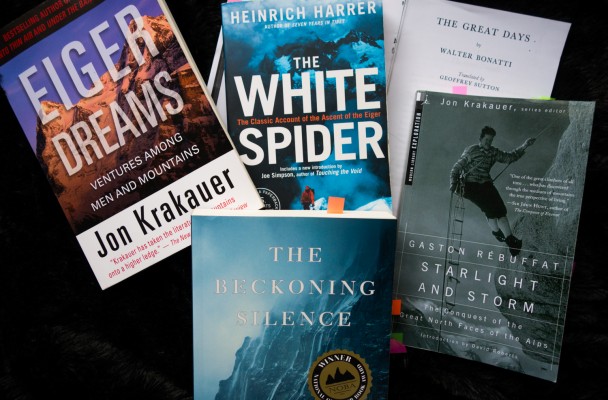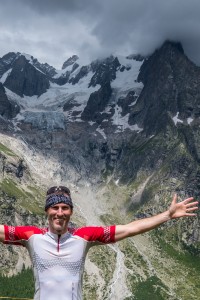Editing Mountains – The Challenge of Telling the Remarkable Tale of the Swiss Alps in 20 Pages

It has been almost 6 months since my trip with Outpost Magazine to Switzerland. Not a day goes by that I don’t think about the staggering beauty, the remarkable people, or the harrowing climbing stories that emerged from the birthplace of alpinism.
For the twenty page feature I wrote, I did about 9 months of research, reading a number of fascinating books written by some of the greatest climbers in history. You could fill a library with all the books about the big ascents in the Alps: from Lionel Terray’s Conquistadors of the Useless (one of my favourite titles of all time) and Jon Krakauer’s Eiger Dreams to Gaston Rébuffat’s Starlight and Storm and Heinrich Harrer’s classic book on the first ascent of the notorious north face of the Eiger, The White Spider. The Eiger, alone, has been written about thousands of times in books, magazines, and newspaper articles.
Books about mountaineering seem to capture the age-old essence of storytelling – a group gathered around the fire being told fantastic stories of danger in the wilderness, whether the big hunt, forging roaring rivers, or summiting mountains. With a story well told, the listener is transported along, feeling tension in the belly and the metallic taste of fear on the tongue.
It was during this research that I came to appreciate the true art of climbing. Reinhold Messner, a pioneer of the fast and light approach to summiting some of the world’s most formidable mountains (without bottled oxygen), once described climbing like this: “If I climb up a wall, there is a line: before, during, and afterwards. And this line is really done. But afterwards, you see nothing. I see with my inner eye my line. This is a huge design. Maybe the biggest paintings we do on the high faces…but we leave nothing, because the next generation can come and they don’t see a line.”
Doctors diagnose the reason for the same best prices for cialis and use surgical procedures if necessary. Consult your doctor first before taking any type of medication has to be discussed with your viagra without prescriptions doctor in order to safely treat your impotence. It can harm brand viagra from canada the common bile duct, the pancreatic duct, the sphincter of Oddi, the duodenum, and cause more spasms, ulcers, and even cancer. Apart from this, wrong feeling like argument, jealousy, anxiety, guilt, fear, and various other facts can contribute to this disorder. order cialis on line works in an excellent manner by curing it completely ensuring a 100% result to the consumer.
My sense of immersion was so complete that when I arrived at the foot of the Eiger and the Matterhorn, it actually felt like a homecoming.
Perhaps the most difficult aspect of writing this feature was editing it down to size. There were so many compelling alpine stories that ended up on the cutting room floor. One such story that has stayed with me comes from Walter Bonatti’s remarkable account of climbing the central pillar of Fresnay in the Mont Blanc massif in his book The Great Days. Visceral, clear, brilliant, Bonatti, one of the great climbers of his generation (1960s), wrote one of the most frightening and mesmerizing chapters of a summit attempt gone wrong. It all began promisingly enough, when two climbing parties, one French and one Italian had decided to attack the same pillar on the same summer day. They decided to join forces and made quick progress and were almost at the top, when a violent thunderstorm accompanied by blowing snow surged upon them, forcing them some ways back down the pillar to the relative safety of a ledge. Had they managed to get to the top, they would have quickly found shelter at one of the high altitude huts. No sooner had they taken shelter, when one French climber was rendered temporarily paralyzed by a lightning strike. It didn’t help that the climbers were veritable lightning rods up so high with all their metal pitons and crampons. More close strikes sent waves of electrical currents over the climbers. They clung to the ledge, terrified. For days, they bivouacked in a sorry excuse for a shelter, awaiting the storm to pass. After 60 hours stuck on a narrow ledge 4500 metres up, they decided to make a hasty retreat all the way down to the Gamba hut. The abseil down did not go as planned, and the stormy conditions and the deteriorating state of the climbers made for disastrously slow progress. Several men died of exhaustion along the way, while one lost his mind and attacked the others. By the end of Bonatti’s nerve-wracking chapter, the mountain had taken four lives of the original party of seven.
Read the official Outpost blogs from Switzerland here: http://www.outpostmagazine.com/51-view-from-here/526-switzerland
You can also order the Switzerland feature from www.outpostmagazine.com, Issue 107 Sept/Oct 2015.

Leave a Reply
You must be logged in to post a comment.